Table of Contents
Bumblebee Goby Care
Bumblebee goby fish require a ten or 20-gallon tank to thrive. They also need a substrate made of fine sand because they are bottom feeders, as well as salty water to mimic their natural environment. The water temperature in their tanks should be between 72 to 84 degrees Fahrenheit.
Bumblebee Goby Overview
When you think of the term Bumblebee Goby, you expect the fish to look huge in appearance. However, these cute little critters are the complete opposite and feature a unique and striped bright appearance to them that is nothing but a show-stealer.
Naturally, these fish are found in Indonesia, Vietnam, and Thailand where they are usually found in rivers and streams, in which the water is brackish and has many hiding spots.
We will talk about their diet, breeding, requirements, and many other subjects concerning these fish. Continue reading to learn all that information.
| Information Chart | Bumblebee Goby |
| Scientific name | Brachygobius Xanthomelas |
| Family | Brachygobius |
| Care level | Intermediate to Advanced |
| Temperament | Peaceful |
| Color | Black and yellow alternate stripes |
| Lifespan | 2-3 years |
| Size | 1.5 inches |
| Minimum tank size | 10-20 gallons |
| Temperature | 72 to 84 degrees Fahrenheit |
| Water conditions | Brackish water |
| Tank mate compatibility | Peaceful, same-species tanks |
Bumblebee Goby Appearance

When talking about bumblebee goby, the first and likely the most important prospect to their existence that stands out is their appearance. Given that they are called bumblebees, they derive their name from their striped appearance. Some feature bright yellow streaks on their bodies, while others feature the staple black and white stripe.
The alternating black and yellow stripes make them stand out, especially when placed against a dark-colored substrate inside the tank. The intensity of the yellow stripes on the body varies from the kind of care they are getting and their natural habitat. However, you will find some freshwater goby with pale yellow stripes and a few others feature bright yellow or orange stripes to their appearance.
The male freshwater goby fish are more vibrant than the female ones, inclined towards the pastel yellow variants.
The overall structure of their body is slender with a small round head that mimics the shape of a “goby” and hence the name. The bulbous eyes are a giveaway in this fish species. Their fins are most clear or transparent, with bright black spots all over them.
Lifespan of Bumblebee Goby
The typical lifespan of a bumblebee goby is between 2-3 years, depending on the kind of care they are getting and the environment they are growing up in. Although ideal for beginners, they also work well among intermediate and advanced aquarists who take special measures and precautions to help them live a longer life.
With quality care and good genetic predisposition, some freshwater gobies tend to live a lot longer than their standard anticipated lifespan. Aquarists, in that case, need to provide the fish with optimal water conditions and stress-free life to ensure that they don’t feel pressured being in that environment or under any stress.
Bumblebee Gory Size
The typical bumblebee gory size goes up to a maximum of 1.5 inches at maturity. However, that is the longest that they grow at maturity, and more often than not, the surplus of the available ones grows up to 1 inch in size and length.
So, if you are considering housing nano fishes in your home tank, these are an amazing addition. However, you do need to take special care of their tank and water requirements.
Natural Habitat and Origin
The bumblebee goby is a freshwater fish that originated and is naturally found in brackish water. So, they are generally considered fish that grows in areas with mixed salinity of freshwater and saltwater.
All the different variants of the brachygobius xanthomelas that you come across in the wild are native to Asia, especially around Thailand and Vietnam. In these countries, they live in areas vegetated by mangroves and are also found in shallow estuaries.
Since they are generally found in brackish waters in their natural habitat, they aren’t the easiest to take care of, especially when replicating the water parameters. If you are particularly looking to take care of a fish, that would be a piece of cake; this isn’t the one for you at all.
Bumblebee Goby Care and Tank Set-up
Taking care of the freshwater goby can be a little tricky, especially if you are a beginner with little to no information about taking care of nano fish from brackish waters. However, once you get the hang of managing their habitat and replicating the environment in the tank to their likings, you wouldn’t have to worry about much anymore.
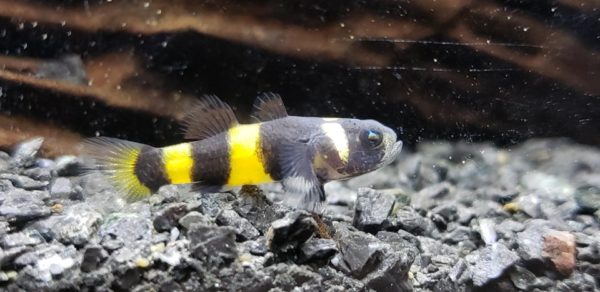
Bumblebee Goby Tank Size and Specifications
When you are setting up the tank for these small tropical fish, the one thing that you need to be mindful of is the specifications. Instead of jumping headfirst into it, educate yourself about their specific needs to provide the fish with optimal living conditions.
Here’s what you need to know:
Optimum Tank Size for Bumblebee Goby
The recommended tank size for bumblebee goby is 10-gallon. Since these fish aren’t huge and aren’t very aggressive or territorial, you can start with a smaller tank and then gradually increase its size depending on how many fishes you end up keeping in the tank.
However, a few reports suggest that housing multiple bumblebee goby in a larger tank has proven benefits in increasing their lifespan exponentially.
Filter Type
When attaching a filter into a tank with bumblebee goby, you want to stick to low-power sponge filters. Creating a stronger water current will make the water conditions inhabitable for the fish, putting them under stress.
Substrate
Bumblebee Goby is a bottom feeder, which means that you will find them navigating down at the bottom of the tank, either in search of food or trying to score themselves some fun hiding spots. So, being mindful of the substrate is important.
Generally, we’d recommend starting with a fine-sand textured substrate on the bottom. This is ideal because these fishes tend to dig into the substrate that is filled in the tank. So, if you put an unnecessary amount of gravels and rocks, you are likely putting them at risk of severe injuries.
Water Parameters for Bumblebee Goby
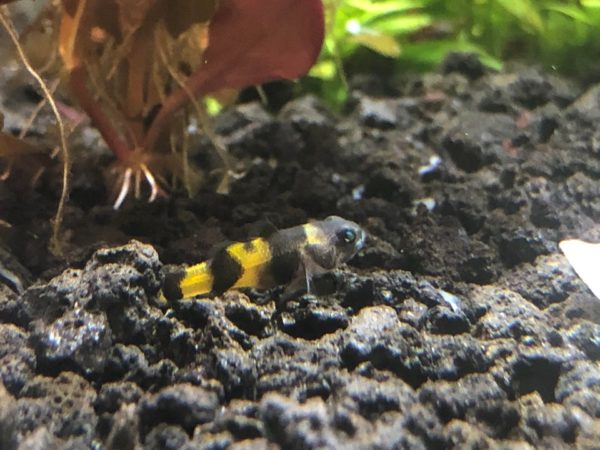
As we have said in the previous sections in the article, the bumblebee goby’s natural habitat is that of salty water. For those who aren’t aware, these water bodies have a mixture of both freshwater and saltwater in them. They are predominantly spotted in estuaries and mangroves areas around different parts of Asia.
So, when it comes to housing and growing them in captivity, you must replicate those living conditions as much as possible to help them live a comfortable lifestyle. From maintaining the ideal temperature to the salinity, there are a few factors worth considering.
We have elaborated on them in this part.
Water Temperature
The ideal water temperature for Bumblebee goby is between 72 to 84 degrees Fahrenheit. This means that they do prefer slightly warmer temperatures of the water instead of the colder streams. Experiences aquarists say that they live the most comfortably when the temperature is between 73.4 to 79 degrees Fahrenheit at all times.
pH Level
The perfect water pH level for Bumblebee goby is 7.0 to 8.5. This is indicative of the fact that these fishes prefer slightly alkaline water conditions. pH levels can easily fluctuate, especially with the waste disposal by the fishes. So, make sure that you check the pH level now and then.
Since the bumblebee goby prefers living in brackish water, you also need to be extra critical about the tank’s salinity. The ideal salinity will be between 1.002 to 1.006 salt grade.
Water Hardness
The ideal water hardness level in the tank should be between 9 to 19 dKH.
Bumbleebee Goby Tank Landscape
While your local commercial aquarists might not have the bumblebee goby in a nicely decorated tank in their shop, you need to realize that these small fishes do prefer many items in their natural surroundings, especially when it comes to replicating their natural habitat.

So, when it comes to decorating their tank, a few additions are an absolute must without any questions.
Besides the sandy substrate, you also need to be mindful of the decorations you add to the tank. These fish, also quite friendly, can be a little shy in the beginning. And, the best way to get them out of their shell is to help them adapt to their settings.
Natural decoration items like live aquatic plants, driftwood, and rocks make good additions to the tank. However, ceramic tubes and coconut hides are also considered good additions to the tank if you want to add further items.
Also, when adding the decorations and the filters and water pump, you need to ensure that you effectively cycle everything, so you have enough time to make adjustments to the water parameters before introducing the fish to the tank.
Feeding Bumblee Goby
Feeding Bumblebee goby is the hardest part of keeping them, as it is tricky to feed them. Usually, they like to eat whatever that is floating around. So you cannot feed them with food that floats on the surface of the water, like flakes.
They like eating live food as well as frozen food. The best option is brine shrimp and blood worms; if you can always have them in the tank, that would be great. As they only eat food when it is moving, otherwise they will ignore it.
These small Asian brackish water fish are strict carnivores, which means that they heavily rely on a protein-rich diet to get their fill. Also, these fish have a habit of rejecting dry food and flakes, so you need to go out of your way to buy expensive live fish feed or frozen food items to keep them fed and healthy in captivity.
If you are looking for idea food choices for the bumblebee goby, some of the popular ones include:
- Bloodworms
- Daphnia
- Tubifex worms
- Brine shrimp
The hard feeding duties, along with the expenses, tend to be a big turn-off for aquarists, especially the beginners who don’t want to spend that kind of money taking care of a fish. However, given how fascinating they look, you won’t regret getting them at all.
Bumbleebee Goby Behavior and Temperament
Bumblebee Gobies are also known as Brachygobius xanthozona. These are small aquarium species of bottom-dwelling fish.
These fish have great behavior. At first, they might be a little shy, but they will show their entire attitude after some time. Male gobies are a bit territorial, and they will immediately take their area in a tank. They may show a little aggressiveness regarding their territory, but it is nothing serious.
However, even when the bumblebee goby is territorial, they aren’t very violent with the other fishes. Instead, the maximum that you will find is some light fighting among the fishes that more or less get resolved when they get bored or tired.
One thing about their behavior that you should know about is that they prefer socializing with their species. So, if you want everyone to get along and have a comfortable time, you need to pair them with other bumblebee goby species only.
Bumblebee Goby Tankmates
These fish usually do not do well in the community, so keeping them in a single species aquarium might be better. And these fish like to be in groups it is better to keep them in a group of 6-7. But overall, they are not aggressive fish, and you can keep them with other species, preferably with non-bottom dwelling species. Just be sure not to keep them with species that can eat them, as they are too small.
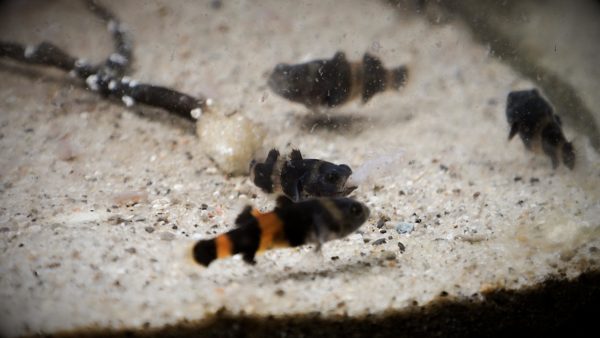
Since these fishes originate from brackish water, finding suitable tank mates that favor their living conditions can be difficult. Many aquarists worry about a fish’s temperament when looking at compatibility for tank mates, but that is the least of your worries with bumblebee goby.
Besides the water parameters, even their small size makes them highly vulnerable in the community tanks. So, make sure that you don’t pair them with fish that will eat them up as their snack or meal.
Ideally, you should prefer keeping them in a single-species tank with other bumblebee goby to reduce stress risks. Also, when you keep them with their kind, it becomes a lot easier to manage and maintain them and their health.
Some of the other compatible tank mates that aren’t their kind include:
Also, keep in mind that the bumblebee goby fish is sociable, which means they need to be kept in groups instead of alone. Males will clash from time to time when it comes to being territorial, but in that case, you need to be mindful of providing them with enough space around the tank to let them roam around freely.
Breeding Bumblebee Goby
Breeding these fish is again not the easiest task, but still, it is possible under the right circumstances.
You will find that spawning ideally takes place when the time is right and when the male and the female fish feel comfortable in the tank. One of the best ways to kickstart the spawning process is by feeding them a protein-rich diet for a brief period. Follow it up by introducing a little freshwater in the breeding tank. Moreso, increase the temperature up to 84 degrees Fahrenheit.
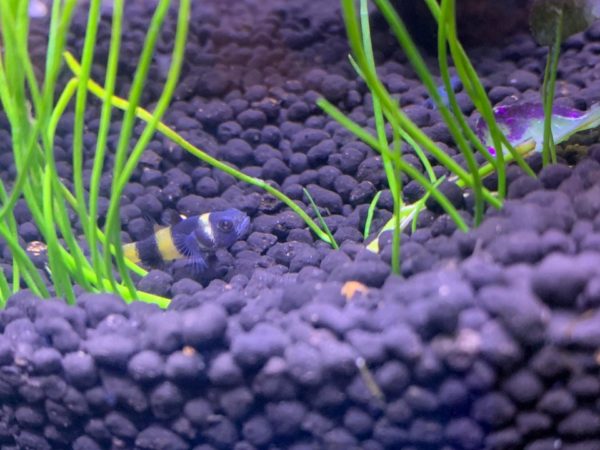
Once the conditions are favorable, the female Bumblebee Goby can lay up to 200 eggs at once. If you want to spot the pregnant female, you will find their abdomen a little swollen.
They lay eggs in a small ceramic tube, in shells or flower pots. When you notice that the female Bumblebee gobies are more swollen and the male has a brighter coloration, they are ready to mate.
Once the eggs are successfully laid, you must immediately separate the female fish from the tank and keep the male fish.
You can move the eggs to another tank to let the fry survive. The incubation period lasts from 7 to 9 days. The hatched fry is extremely small and will take up to a week to 10 days to start swimming around the tank freely. You need to feed them infusoria till they are mature enough to switch to an adult diet.
Bumblebee Goby Disease and Their Treatment
You are pretty much well-versed about the bumblebee goby and their lifestyle. However, what about diseases and their respective treatments. As much as it is hard to maintain these fish, they contract a few different types of diseases that you need to be mindful of.
Two of the most common contributing factors behind bumblebee goby diseases are stress or poor water conditions. Any spiked fluctuations in the salinity levels can put the fish under stress and even cause the staple Ich disease.
Although you will eventually get the hang of it but maintaining optimal water conditions for the bumblebee gobies is a necessity, more than a choice. From the pH to the water’s temperature, any rampant fluctuation will result in a range of diseases.
Avoid putting them in a freshwater tank because they won’t survive at all. However, keep in mind that a few types of freshwater bumblebee gobies are available in the market. All you need to do is have an open conversation with your aquarist about buying the fish.
After introducing the fish to the brackish water home aquarium, you need to keep a close eye on their well-being and salient growth. If you find anything amiss with their personality, the chances are that they are under stress and 9/10 times due to poor water conditions.
The best way to prevent the onset of diseases and other stress-inducing situations is by checking the water parameters closely every day.
Are Bumblebee Goby Right for You?
You need to be careful when buying these fish in a fish store as usually, it is hard to distinguish between Brachygobius fish, as they all look similar. So if you cannot distinguish between them, it is better to buy them from a person who will not lie to you and give you the right species.
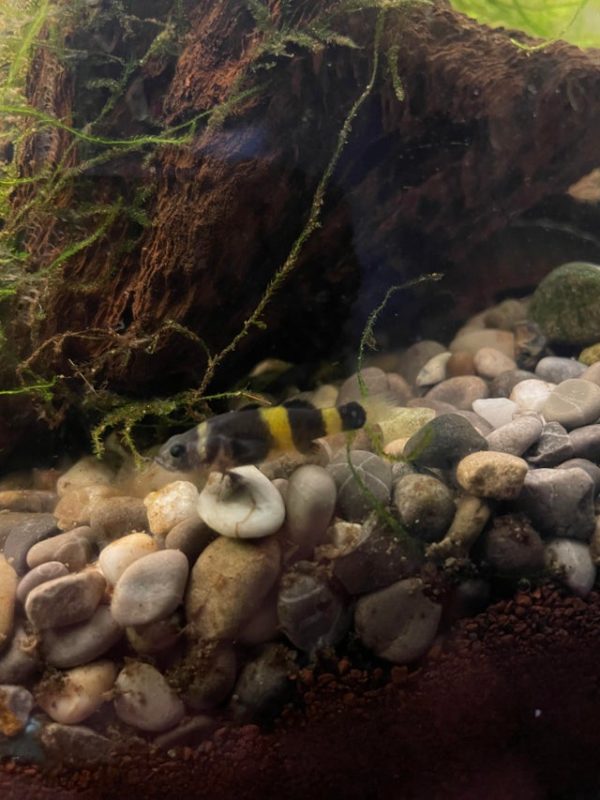
One of the advantages of these fish is that they are very peaceful. Unlike many other fish species that might not get along with each other, bumblebee gobies are peaceful compared to other species.
Also, Bumblebee gobies are a beautiful addition to the aquarium, as they have beautiful coloring. Especially with their black and gold stripes that go along from head to tail.
And the last reason we recommend getting Bumblebee gobies for aquarists who want a challenge for themselves.
FAQs
Can bumblebee goby live in freshwater?
The majority of the bumblebee goby species available in the market typically originate from the brackish waters in parts of Asia. So, you need to house them in conditions that mimic their original habitat. However, a few types of freshwater bumblebee goby can live in freshwater conditions with ease.
How many bumblebee gobies should be kept together?
Bumblebee gobies are friendly and like to interact with other fishes in the tank. So, if you consider adding them to your tank, you need to buy them in a minimum group of 4-5 for a comfortable life.
Are bumblebee gobies hardy?
While they are hardy fishes and don’t contract diseases or issues easily, you need to realize that they need high maintenance, both in terms of the food you are giving them and the kind of water parameters they are growing in.
Can bumblebee gobies live with guppies?
Yes, both bumblebee goby and guppies make for compatible tankmates, both due to the kind of water conditions they require and the kind of size they have.
Do bumblebee gobies eat snails?
Yes, bumblebee gobies can feed on snails since they are primarily carnivores and like to stick to a protein-rich diet for optimal health and growth.
Conclusion
Bumblebee gobies are not that easy to look after, but overall they do not require extreme effort. Just make sure to create a needed environment for them, and everything will work out fine. If you are considering switching up your home tank to house some brackish water fish, these should be the first ones on the list around.
We hope this guide gives you all the information that you have been looking for. In case you have further queries, make sure you leave them for us in the comments below.
No related posts.

2 thoughts on “Bumblebee Goby: Complete Guide to Care, Breeding, Tank Size and Disease”
Is the bumblebee goby and the bumblebee catfish the same fish?
No, not at all. Same markings, but that’s about all they have in common.